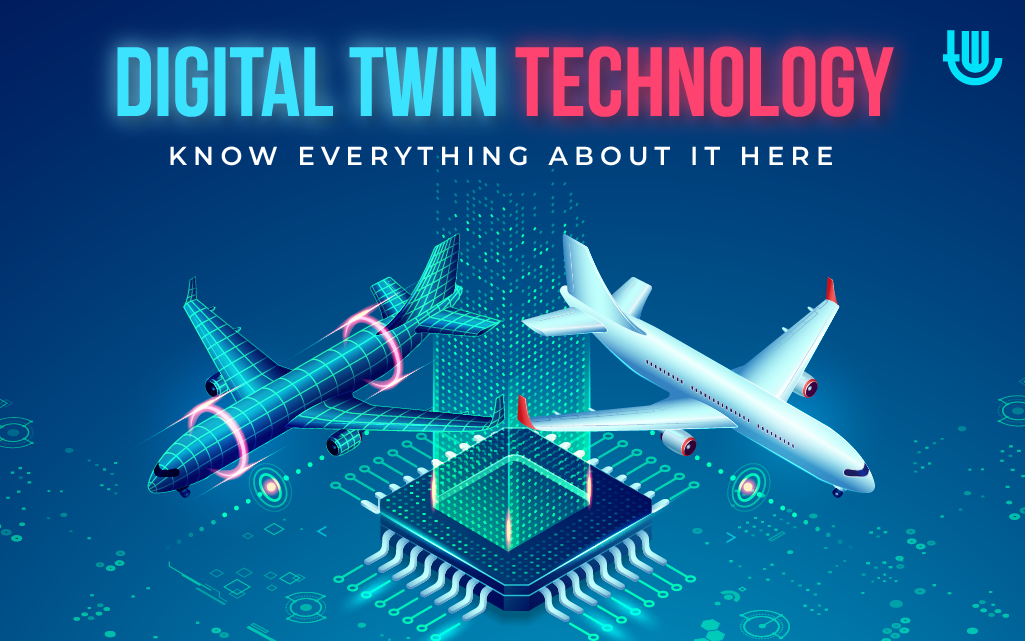
People perhaps have an idea of digital twin technology, since it is a widely discussed topic from 2002. However, the major implementations are seen recently due to its cost-effectiveness because of the Internet of Things (IoT). This technology was also recognized as one of Gartner‘s Top 10 Strategic Technology Trends for 2017 due to its importance to businesses today. This blog post will explore every aspect of digital twin technology, including its recent trends, impacts, examples, benefits and drawbacks.
What is Digital Twin Technology?
Just like how twin siblings are, digital twin technology relies on creating and having a virtual replica or representation of a real-world thing, procedure, system, or entity. It combines data from many sources, such as sensors, simulations, and real-time monitoring, to produce a digital copy that accurately reproduces the physical copy’s traits, actions, and results in real time.
Recently, these areas have been widely explored in the banking and financial industry where AI powered bots can replicate day to day operations of banks, such as transfers or ATM systems.
There are also multiple discussions on how digital twin systems of drugs can be used to identify the effects and successes of medicinal experiments in the healthcare industry.
Digital twins originated while exploring the Internet of Things (IoT), a technology that allows physical items to connect to the Internet and broadcast information about their status and operation. Organizations can learn more about the behavior and performance of the physical entity by creating a digital twin.
Recent Trends in Digital Twin Technology
Several recent trends have emerged in the field of Digital Twin technology. Here are a few notable trends:
Integration with AI and ML
Digital Twins are increasingly incorporating AI and ML algorithms to enhance their capabilities and learn the behavior of the real life systems. Digital Twins can analyze complicated data patterns, spot abnormalities, and generate precise predictions of physical entities by utilizing AI/ML approaches.
Extended Reality (XR) Integration
Digital twins are already integrated with augmented reality (AR) and virtual reality (VR) to enable immersive visualization and interaction with the virtual model. With XR integration, users can instantly simulate and view virtual data over physical objects, enhancing collaboration, training, and maintenance processes.
Edge Computing and Real-time Processing
With the growing adoption of edge computing, Digital Twins are being deployed closer to the physical entity they represent. This decreases the time lag and enables quicker decision-making by providing real-time analysis.
Digital Twin Ecosystems
Connected and integrated into broader ecosystems, digital twins allow for cross-entity cooperation and information sharing. For instance, in “smart cities,” digital Twins of different urban systems (such as transportation, electricity, water, etc.) can communicate and share information, enabling more comprehensive decision-making and optimization.
Cybersecurity and Data Privacy
As Digital Twins generate and process massive volumes of sensitive data, maintaining cybersecurity and data privacy has become a top priority. To defend Digital Twin ecosystems from cyber attacks, recent advancements include the implementation of strong security mechanisms, encryption methods, and privacy frameworks.
Impacts of Imparting Digital Twin Technology in Our Lives
The plethora of applications having Digital Twin technology has the potential to alter and transform our lives significantly. We can completely change how we connect with and manage the physical world by utilizing digital twins’ superpowers.
With real-time data, simulations, and predictive analytics, digital twins offer a comprehensive view of physical entities. This makes it possible for people and organizations to make accurate and business-oriented decisions based on the present information.
Digital twins enable us to make data-driven decisions resulting in better performance, lower risks, and increased operational efficiency, whether optimizing operations, identifying maintenance needs, or forecasting outcomes.
In addition, digital twin technology can change our lives by enhancing productivity, sustainability, and efficiency. No matter what industry we work in—manufacturing, healthcare, transportation, or urban planning—this technology provides us with the power to streamline procedures, make wise choices, and open fresh avenues for innovation.
To conclude, we can build a more interconnected, effective, and intelligent world by utilizing the insights and capabilities of digital twins.
What Are Some Top Examples of Digital Twin Technology?
There are several notable examples of Digital Twin technology across various industries, we try to enlist some of them below:
Manufacturing:
General Electric (GE) has pioneered implementing Digital Twins for their industrial equipment. For instance, they have created digital twins for jet engines that enable real-time monitoring and analysis of engine performance, scheduling, and problem prediction.Smart Cities:
Singapore pioneered using digital twins for managing and planning metropolitan areas. They have created Virtual Singapore, a thorough Digital Twin of the city-state. It integrates several data sources, including those for buildings, transportation, and the environment, to simulate and analyze urban scenarios for improved urban planning and decision-making.Aerospace and Defense:
NASA has employed Digital Twins to simulate and monitor the International Space Station (ISS). The Digital Twin helps to analyze the ISS’s health and performance, forecast maintenance requirements, and support decision-making for crew operations.
Pros and Cons of Digital Twin Technology
Every technology comes with certain pros and cons, and digital twin technology is no exception. Here are some pros and cons:
Pros of Digital Twin Technology
- It can simulate real-world scenarios, enabling organizations to optimize processes and identify areas of improvement.
- It can help reduce costs by identifying inefficiencies, predicting maintenance requirements, and optimizing resource allocation without actively engaging in the real world.
- It provides real-time data and insights, allowing organizations to make informed decisions quickly.
Cons of Digital Twin Technology
- Creating an accurate digital twin that reflects the real-world system can be challenging, requiring expertise in modeling and simulation.
- Having a sustainable digital twin technology requires collecting and analyzing vast amounts of data, which raises concerns about privacy and security.
- It can be a complicated process to integrate digital twin technology with existing systems.
Final Thoughts
Digital twin technology has enormous potential for revolutionizing companies and processes across multiple sectors. Organizations should carefully analyze their goals, capabilities, and resources to determine if and how digital twin technology can be effectively applied to accomplish their desired outcomes. Organizations may realize the full potential of this game-changing technology by carefully pursuing digital twin adoption and addressing the related issues.

Author Bio: This article has been written by Rishika Desai, B.Tech Computer Engineering graduate with 9.57 CGPA from Vishwakarma Institute of Information Technology (VIIT), Pune. Currently works as Cyber Threat Researcher at CloudSEK. She is a good dancer, poet and a writer. Animal love engulfs her heart and content writing comprises her present. You can follow Rishika on Twitter at @ich_rish99.